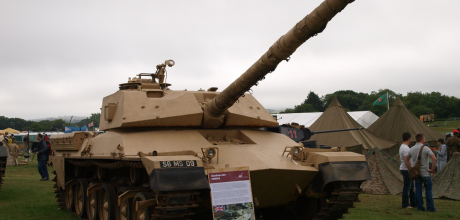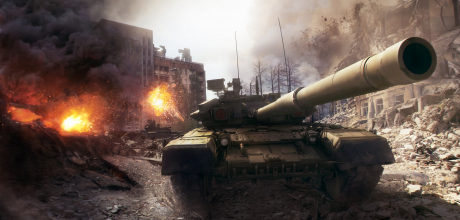
The M60 interim tank was developed as an upgrade to the M48 series with the goals of improving its firepower and operational range. The project was relatively successful and the combination of a new 105mm gun and a diesel engine proved to be a formidable one, but there was still a lot of space for improvement, especially in the turret department.

USMC M60A1 during Operation Desert Storm
The M60 was supposed to originally be equipped with a new turret, based on the T95 tank program (specifically the T95E7 variant, designed with a 105mm gun in mind). The T95 turret was sleek and, most importantly, better protected than the original M48 turret. The turret was also longer, allowing for the gun to be shifted more to the front, thereby increasing the internal space for the crew. However, by the time the M60 went into production, it was not ready yet and the initial M60 model was therefore equipped with a modified M48 turret. That, of course, did not stop the ongoing development.
The attempts to mate a modified M60 hull with the T95E7 turret took place from March 1960 with the first two prototypes (designated Pilot 1 and 2) ready in May 1961 and the third (Pilot 3) in June 1961, when the vehicle also received its official designation: 105mm Gun Tank M60E1.
The vehicles were built by Chrysler. The first prototype was sent to Aberdeen for testing, the second went to Detroit Arsenal for maintenance testing, and the third one was assigned to Fort Knox.
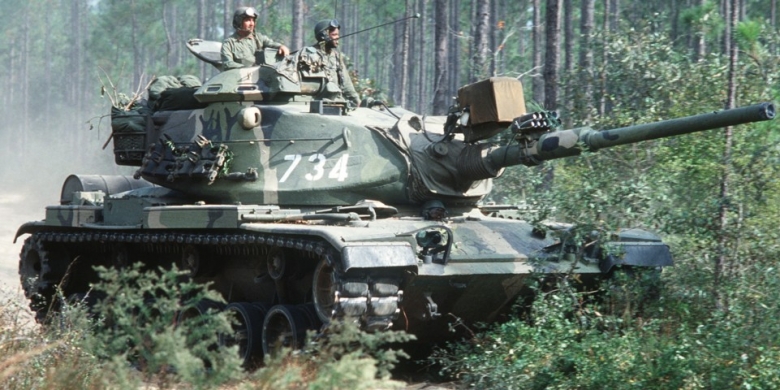
M60A1
The vehicle showed much promise. The suspension was further improved compared to the older M60 model. The new (all-steel) turret was well-protected:
- Gun mantlet: 127mm (angled at 60 degrees – the line of sight mantlet armor changed from 130mm to 254mm)
- Turret front: equal to 254mm
- Turret sides: equal to 140mm
- Turret rear: equal to 57mm
- Turret top: 25mm
As you can see, the line of sight armor thickness was practically doubled. Given the fact that the majority of the hits were expected to impact on the turret rather than the hull, the new turret represented a massive jump in M60 protection.
The M60E1 was also equipped with a number of advanced electronic devices, such as:
- XM16C electronic computer
- XM35 gunner sights with IR capability
- M17C coincidence rangefinder
- XM34 or XM36 commander periscope (the latter had IR capability)
The turret was covered with the M19 cupola, known already from the original M60. In this configuration, the vehicle passed the military tests successfully, although some additional modifications were made (such as replacing the older M17C coincidence rangefinder with the newer M17A1 model).
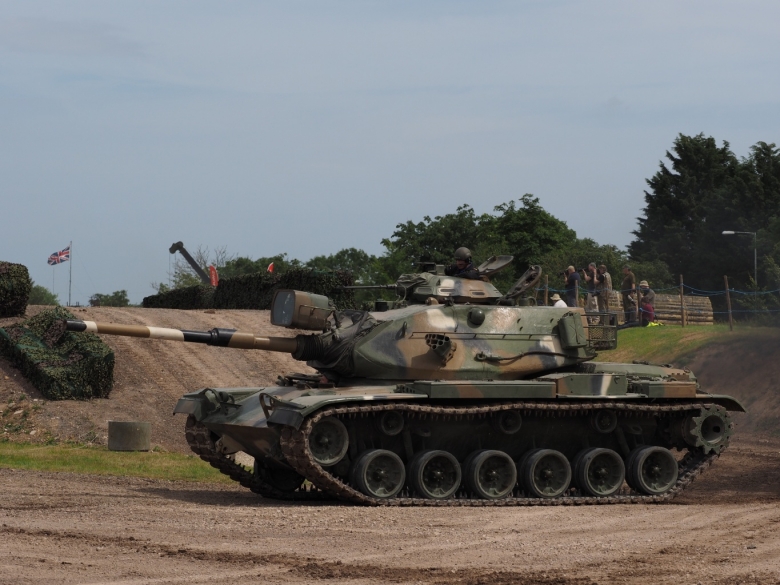
M60A1
On October 22 1961, the M60E1 was officially accepted in service under the designation of 105mm Gun Tank M60A1. It would take a full year (till October 1962), however, before the production switched to this upgraded variant.
The M60A1 had – compared to the M60E1 – an improved hull armor. It remained steel-only, no composites were used, but the upper frontal plate thickness was increased:
- Upper frontal hull plate: 109mm (angled at 65 degrees, increased from 93mm)
- Lower frontal hull plate: 143-85mm (angled at 55 degrees)
- Side hull armor: 74-36mm
- Rear hull armor: 41-30mm (the grill was 25mm thick)
- Hull bottom: 19-13mm
- Hull top: 36mm
The original M60 engine (AVDS-1790-2 650hp diesel) was replaced by yet another improved variant (the AVDS-1790-2A), the main advantages of which were reduced exhaust smoke and fuel consumption – the power remained the same, as did the maximum speed (48 km/h, 30 mph), even though the combat weight was increased (compared to the M60) by 1.36 tons to 47.63 tons. It took approximately 35 seconds for the vehicle to reach its maximum speed on hard surface.
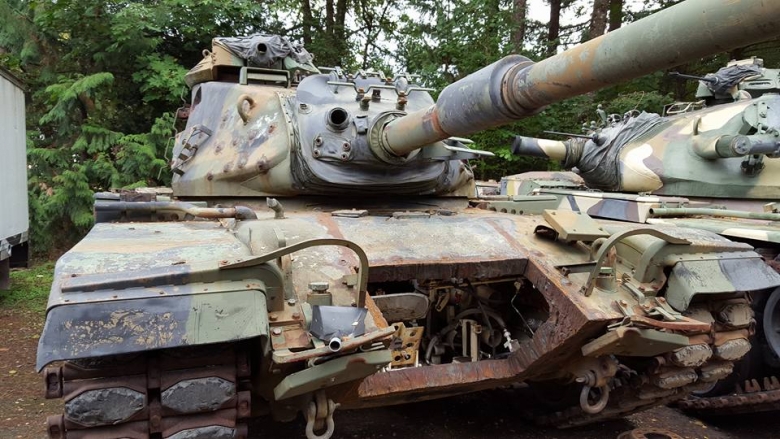
M60A1 hull armor cutaway
The gun was still the 105mm M68 rifled cannon, but the gun mount was changed from the M116 model of the M48 turret to the M140 model, allowing the vehicle to have better gun depression and elevation (-9/+19 increased to -10/+20). The amount of ammunition carried was increased from 57 to 63 rounds.
In this configuration, the M60A1 stayed (with improvements, counting the M60A3 amongst them) in the American service for four decades, an exceptional machine for what was supposed to be a temporary solution in the first place. The failure of the T95 program and the MBT-70, as well as the lengthy Abrams development, pushed the retirement of the M60 series further and further with the final replacement of the M60A3 with the Abrams in the last active units only happening in 2005. A large number of M60 tanks are, however, still held in reserve.
In American service, the M60A1 participated most notably in Operation Desert Storm – the M60A1 model was still operated by the U.S. Marine Corps at that time, apparently due to the fact that USMC decided to wait for an upgraded version of the Abrams before replacing the obsolete Pattons with it, instead of choosing one of the older Abrams models just to replace it a few years later.

Egyptian M60A1
The Marine M60A1 crews were also trained on these vehicles and the M60A1s with an ERA kit were better protected than the Army M60A3TTS. Some of the Marine M60A1s were equipped with dozer blades – these tanks were part of the Marine breach teams and cleared the way for other Marine tanks.
During the operation, the modern American 105mm APFSDS rounds had little trouble penetrating the motley assortment of obsolete Soviet and Chinese vehicles and the M60s in general were (when it came to tank-killing capabilities) roughly on par with the Abrams, something that can be rather attributed to extremely poor Iraqi training than the quality of the vehicle itself.
The M60A1 was also widely exported to NATO countries and American allies. Possibly the biggest M60 series operator was Israel with 150 M60A1s purchased in 1971, two years prior to the Yom Kippur War, during which many of them were destroyed, especially on the western front with Egypt, where Egyptian Malyutka teams, along with dug-in BMP-1s, devastated the Israeli armored assaults with precise fire. For such a small country, these losses were difficult to replace.

U.S. M60A1 in Germany, 1982
Between 1980 and 1985, Israel purchased more M60-series tanks (but that was the advanced M60A3 model already). The M60s (under the Magach designation) were upgraded further and were only retired in 2014.
Other M60A1 operators included or include:
- Italy (300 vehicles, in active service until 1994)
- Egypt
- Greece
- Jordan
- Oman
- Saudi Arabia (some Saudi M60s took part in Desert Storm, but were of very low value due to poor crew training and poor maintenance)
- Thailand
- Turkey
- Yemen
The exact number of export vehicles and variants is difficult to track, as various sources state various numbers and types. The majority of the M60 exports seem to have been of the later M60A3 variant, but that is a story for another time.
The M60A1 will continue in the M60 tradition as a sufficiently mobile and protected American MBTs with good firepower for its tier, which are, most importantly, comfortable to play thanks to their gun depression.
Stay tuned for more information, we’ll see you on the battlefield!




